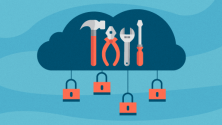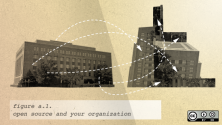Like open source, innersource is all about being transparent and collaborative. This usually leads to a sense of belonging that favors employee happiness if done right. Regardless of org charts, geographies, or expertise levels, innersource creates an inclusive environment where employees contribute and collaborate in the open and learn from one another.
Innersource enables agility and quality
When everyone defaults to transparency, silos tend to disappear, and employees save time by reusing code, processes, or best practices from different parts of the organization. Innersource also enables asynchronous collaboration through written communication. By documenting everything from the decision-making process to metrics and how-to guides, employees no longer need to schedule so many meetings or fear missing out if they can't join one. This is a game-changer in terms of agility and efficiency across the board.
Openness naturally leads to more scrutiny. With scrutiny comes feedback and iteration, which yields tremendous benefits in quality and buy-in from the various stakeholders. In other words, innersource is a forcing function for everyone in a given organization to hold themselves accountable to higher standards.
Why is innersource gaining momentum now?
To understand why innersource is gaining momentum, look at its three pillars:
-
Culture: Open source is becoming more deeply rooted in many company cultures and DNA. For instance, companies like US Bank or Capital One have a dedicated headcount as Head of Open Source with a specific mandate to develop an innersource culture internally. Even better, more and more enterprises have decided to open source most of their in-house software. The most famous one is probably Netflix OSS, which has released more than a dozen projects as open source over the past few years—from big data to build, runtime, and delivery tools.
-
Process: As the pandemic spread and employees got sent home, organizations had no choice but to embrace this innersource culture and adapt processes to work more asynchronously. As Zoom fatigue set in, it seemed like a fair amount of decisions got taken outside of meeting rooms in a more collegial way, with key stakeholders able to comment and provide feedback beforehand. For instance, offline decision-making through GitHub issues is more conducive to the disagree and commit management principle. It gives stakeholders more time to think about important changes. It also forces them to build a solid, documented case for or against the decision.
-
Tools: New innovative tools can act as triggers for the innersource flywheel. They have the power to impact processes that affect the overall culture, thus becoming more open to adopting new tools. For instance, new SaaS companies bring down the legal barriers of remote work for HR professionals. Other tools such as Penpot and Nextcloud enable distributed teams to get work done collaboratively.
How can my company start embracing innersource?
Now that you understand what innersource is, its benefits, and why it's gaining popularity, you might wonder where to start. Take a look below at three ways you could bring innersource to your company.
1. Company handbook
Although a bit counterintuitive at first for fear of direct competitors copying it, my company, Strapi, recently published the company handbook publically. The success of the GitLab Handbook inspired Strapi to follow suit. The GitLab handbook is an open source reference in the tech world. Most notably, the benefits of having a public handbook include improved communication and a transparent hiring and onboarding process. It also helps companies build trust and alignment with their external stakeholders or communities.
2. Public roadmap
Public product roadmaps are also becoming a standard in the tech industry. In addition to providing visibility into what features they expect to develop (and when), it also gives everyone the opportunity to upvote and comment. Providing a clear avenue for feedback lets the users know that their voices get heard and that the community participates in the product build.
3. Public meetings
Another example of how innersource can change the work culture is public all-hands meetings where users ask company founders or executives questions as if they were full-time employees. For instance, Airbyte runs this type of meeting monthly to gather feedback and build relationships with community members in an informal setting.
Conclusion
Innersource, which started as an engineering principle out of the open source software world, is now spreading to other departments and industries. As workforces become more and more distributed across the globe and new tools and processes enable more effective asynchronous communication, innersource (even though not everyone will call it that) is very likely to keep changing the work culture as we know it.







Comments are closed.